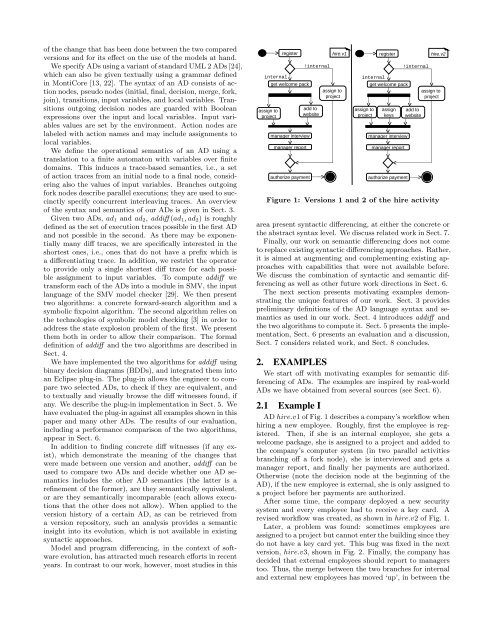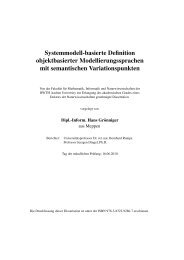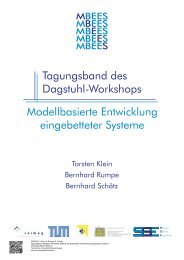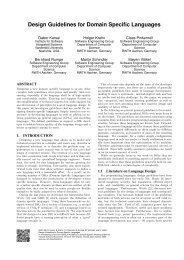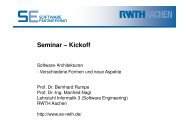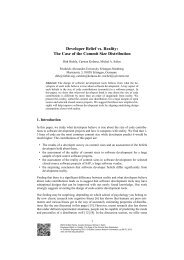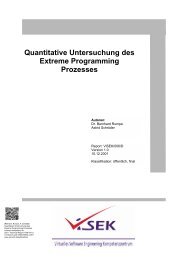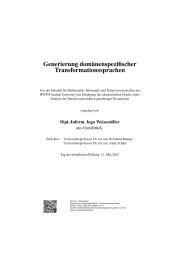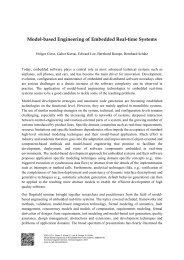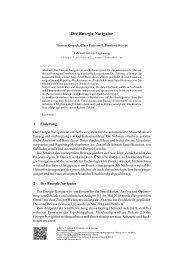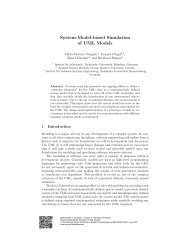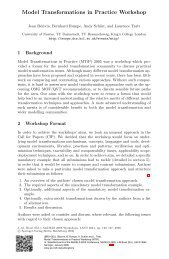Semantic Differencing for Activity Diagrams - Software Engineering
Semantic Differencing for Activity Diagrams - Software Engineering
Semantic Differencing for Activity Diagrams - Software Engineering
You also want an ePaper? Increase the reach of your titles
YUMPU automatically turns print PDFs into web optimized ePapers that Google loves.
of the change that has been done between the two compared<br />
versions and <strong>for</strong> its effect on the use of the models at hand.<br />
We specify ADs using a variant of standard UML 2 ADs [24],<br />
which can also be given textually using a grammar defined<br />
in MontiCore [13, 22]. The syntax of an AD consists of action<br />
nodes, pseudo nodes (initial, final, decision, merge, <strong>for</strong>k,<br />
join), transitions, input variables, and local variables. Transitions<br />
outgoing decision nodes are guarded with Boolean<br />
expressions over the input and local variables. Input variables<br />
values are set by the environment. Action nodes are<br />
labeled with action names and may include assignments to<br />
local variables.<br />
We define the operational semantics of an AD using a<br />
translation to a finite automaton with variables over finite<br />
domains. This induces a trace-based semantics, i.e., a set<br />
of action traces from an initial node to a final node, considering<br />
also the values of input variables. Branches outgoing<br />
<strong>for</strong>k nodes describe parallel executions; they are used to succinctly<br />
specify concurrent interleaving traces. An overview<br />
of the syntax and semantics of our ADs is given in Sect. 3.<br />
Given two ADs, ad 1 and ad 2, addiff (ad 1, ad 2) is roughly<br />
defined as the set of execution traces possible in the first AD<br />
and not possible in the second. As there may be exponentially<br />
many diff traces, we are specifically interested in the<br />
shortest ones, i.e., ones that do not have a prefix which is<br />
a differentiating trace. In addition, we restrict the operator<br />
to provide only a single shortest diff trace <strong>for</strong> each possible<br />
assignment to input variables. To compute addiff we<br />
trans<strong>for</strong>m each of the ADs into a module in SMV, the input<br />
language of the SMV model checker [29]. We then present<br />
two algorithms: a concrete <strong>for</strong>ward-search algorithm and a<br />
symbolic fixpoint algorithm. The second algorithm relies on<br />
the technologies of symbolic model checking [3] in order to<br />
address the state explosion problem of the first. We present<br />
them both in order to allow their comparison. The <strong>for</strong>mal<br />
definition of addiff and the two algorithms are described in<br />
Sect. 4.<br />
We have implemented the two algorithms <strong>for</strong> addiff using<br />
binary decision diagrams (BDDs), and integrated them into<br />
an Eclipse plug-in. The plug-in allows the engineer to compare<br />
two selected ADs, to check if they are equivalent, and<br />
to textually and visually browse the diff witnesses found, if<br />
any. We describe the plug-in implementation in Sect. 5. We<br />
have evaluated the plug-in against all examples shown in this<br />
paper and many other ADs. The results of our evaluation,<br />
including a per<strong>for</strong>mance comparison of the two algorithms,<br />
appear in Sect. 6.<br />
In addition to finding concrete diff witnesses (if any exist),<br />
which demonstrate the meaning of the changes that<br />
were made between one version and another, addiff can be<br />
used to compare two ADs and decide whether one AD semantics<br />
includes the other AD semantics (the latter is a<br />
refinement of the <strong>for</strong>mer), are they semantically equivalent,<br />
or are they semantically incomparable (each allows executions<br />
that the other does not allow). When applied to the<br />
version history of a certain AD, as can be retrieved from<br />
a version repository, such an analysis provides a semantic<br />
insight into its evolution, which is not available in existing<br />
syntactic approaches.<br />
Model and program differencing, in the context of software<br />
evolution, has attracted much research ef<strong>for</strong>ts in recent<br />
years. In contrast to our work, however, most studies in this<br />
internal<br />
assign to<br />
project<br />
register<br />
get welcome pack<br />
manager interview<br />
manager report<br />
authorize payment<br />
!internal<br />
add to<br />
website<br />
hire.v1<br />
assign to<br />
project<br />
internal<br />
assign to<br />
project<br />
register<br />
get welcome pack<br />
assign<br />
keys<br />
manager interview<br />
manager report<br />
authorize payment<br />
!internal<br />
add to<br />
website<br />
hire.v2<br />
assign to<br />
project<br />
Figure 1: Versions 1 and 2 of the hire activity<br />
area present syntactic differencing, at either the concrete or<br />
the abstract syntax level. We discuss related work in Sect. 7.<br />
Finally, our work on semantic differencing does not come<br />
to replace existing syntactic differencing approaches. Rather,<br />
it is aimed at augmenting and complementing existing approaches<br />
with capabilities that were not available be<strong>for</strong>e.<br />
We discuss the combination of syntactic and semantic differencing<br />
as well as other future work directions in Sect. 6.<br />
The next section presents motivating examples demonstrating<br />
the unique features of our work. Sect. 3 provides<br />
preliminary definitions of the AD language syntax and semantics<br />
as used in our work. Sect. 4 introduces addiff and<br />
the two algorithms to compute it. Sect. 5 presents the implementation,<br />
Sect. 6 presents an evaluation and a discussion,<br />
Sect. 7 considers related work, and Sect. 8 concludes.<br />
2. EXAMPLES<br />
We start off with motivating examples <strong>for</strong> semantic differencing<br />
of ADs. The examples are inspired by real-world<br />
ADs we have obtained from several sources (see Sect. 6).<br />
2.1 Example I<br />
AD hire.v1 of Fig. 1 describes a company’s workflow when<br />
hiring a new employee. Roughly, first the employee is registered.<br />
Then, if she is an internal employee, she gets a<br />
welcome package, she is assigned to a project and added to<br />
the company’s computer system (in two parallel activities<br />
branching off a <strong>for</strong>k node), she is interviewed and gets a<br />
manager report, and finally her payments are authorized.<br />
Otherwise (note the decision node at the beginning of the<br />
AD), if the new employee is external, she is only assigned to<br />
a project be<strong>for</strong>e her payments are authorized.<br />
After some time, the company deployed a new security<br />
system and every employee had to receive a key card. A<br />
revised workflow was created, as shown in hire.v2 of Fig. 1.<br />
Later, a problem was found: sometimes employees are<br />
assigned to a project but cannot enter the building since they<br />
do not have a key card yet. This bug was fixed in the next<br />
version, hire.v3, shown in Fig. 2. Finally, the company has<br />
decided that external employees should report to managers<br />
too. Thus, the merge between the two branches <strong>for</strong> internal<br />
and external new employees has moved ‘up’, in between the


